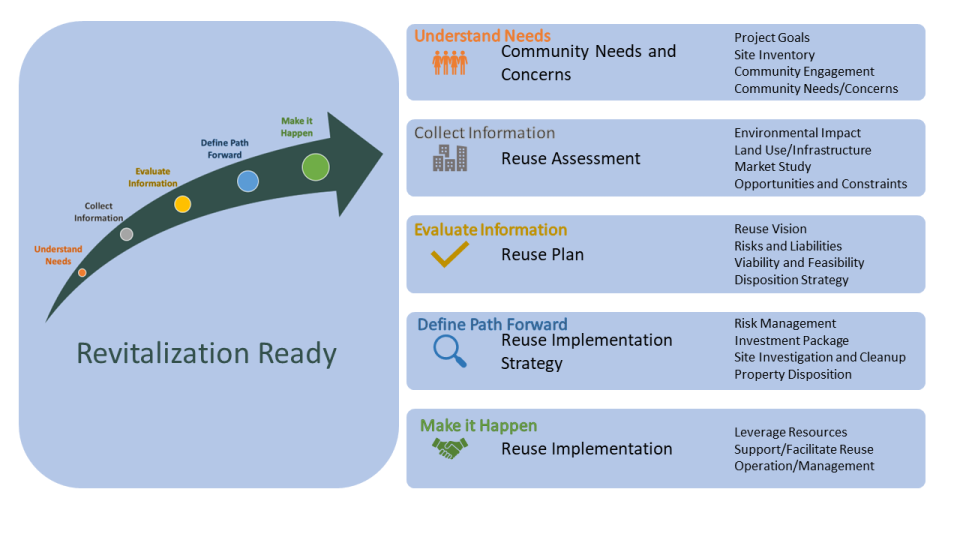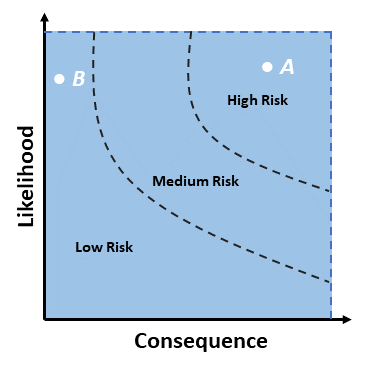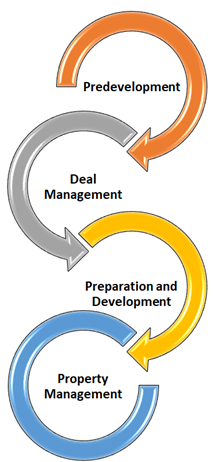Revitalization-Ready Guide: Chapter 1: Introduction

Overview
This guide uses the term “brownfield” to refer to a property:
- that is abandoned, idled or underutilized and possibly contaminated,
- where contamination is suspected or is known to exist, and
- where the cleanup strategy includes safely managing residual contamination (such as maintaining a protective cover system or cap, deed restrictions, etc.).
The U.S. EPA defines a brownfield as “a property, the expansion, redevelopment, or reuse of which may be complicated by the presence or potential presence of a hazardous substance, pollutant, or contaminant.”
The Revitalization-Ready (Ready) Guide is designed to help your community redevelop the contaminated, potentially contaminated, idle and underused properties in your city or town. It describes how you can initiate and lead the redevelopment process by understanding your community’s needs, collecting and evaluating information, and defining the path forward to make the redevelopment happen.
Your community’s decision to move forward on a redevelopment project will be based on answers to the following core questions:
- Will the selected project meet your community’s needs – social, public health, environmental and economic goals?
- Is the project financially viable and realistic?
- Are the risks acceptable?
- Are the necessary resources available?
The Ready process is mapped out as six sections in this guide. Working through each section will help your community address the questions above and evaluate various property redevelopment options.
The Ready Guide:
- Provides a general process for evaluating a brownfield property to return it to a productive reuse.
- Discusses key steps in the process of redeveloping a contaminated, potentially contaminated, idle or underused property.
- Addresses key questions and other factors that should generally be considered in implementing each step.
- Summarizes relevant background information and provides references to other sources of information.
- Provides a Workbook that can help guide and support the evaluation and decision making process for a specific project.
Local governments interested in facilitating the cleanup and reuse of brownfields, other contaminated properties, idled and underutilized properties can use the Ready Guide insights and activities. The term “local government” (as used in the Ready Guide) includes local, regional, and county governments, tribes, and quasi-governmental organizations.

States and non-governmental organizations (such as non-profits) can also use the information and actions the Ready Guide, but keep in mind that federal and state laws provide certain liability protections and authorities that may only be available to “local government” entities.
The potential actions generally available to your community (including local governments and other redevelopment entities) are referred to in this guide as "property disposition strategies." These strategies may include acquisition approaches and non-acquisition approaches (e.g., transferring tax liens). Several of these strategies are explained in this guide.
Background
In an effort to ensure community vitality, a strong tax base, and the health and safety of residents, your community may face the prospect of acquiring- or taking other actions - to facilitate reuse of one or more brownfield properties.
Brownfield properties are often difficult to redevelop due to concerns regarding the environmental conditions and potential liability. In cases where contamination complicates the reuse of a property, local governments or development authorities can play a pivotal role in transforming these properties into community assets. This often becomes more important when economic slowdowns put downward pressure on real estate markets.
In many communities across the country, contaminated properties representing every stage in the cleanup process are being successfully reused as the result of local government involvement. This includes Superfund sites and other properties with serious environmental issues. Generally, a strong and realistic site redevelopment plan helps increase environmental protection at the site.
Nevertheless, it is common for a community to struggle with potential legal liability and other complications associated with the environmental conditions of a brownfield property. This is particularly true of smaller cities or towns and nonprofits that often operate with limited in-house staff and budgets. Outside legal counsel and specialized consultants can provide essential expertise, but generally serve only in an advisory capacity. Ultimately, the burden of deciding on a course of action usually rests with local government officials or the redevelopment entity.
About Risk Management

A decision-making process generally involves an evaluation of risk. A basic premise of this guide is that project risks involving brownfield properties, like most risks, cannot be entirely eliminated — only managed.
Managing risks requires a fundamental understanding of the risks that may exist, the likelihood of those risks occurring, and the potential consequences if those risks are realized. It also involves prioritizing those risks and taking steps to contain the most significant risks within acceptable limits.
What is deemed acceptable will depend on a number of factors, such as the development entity’s basic goals for the brownfield property and its general sensitivity to risk. This is a determination that must be made by local government and other officials based on the needs of the local community.
The discussion of risk in the Ready Guide includes financial risk, civil/environmental liability, and the need to balance community concerns. Generally, these risk categories are interrelated and should be considered together in evaluating a property disposition strategy. While it can be more complicated to consider several risk components at the same time, the solutions that result from comprehensive consideration of risks are generally more robust and often more financially sound.
Risk management is typically conducted in an iterative, staged manner. Once risks are identified, potential ways to manage these risks are considered, and the risks are reassessed.
For brownfield properties, risk management can involve traditional tools such as insurance products and indemnification agreements, state and federal settlement agreements or statutory liability protections, or other approaches such as gathering additional data, delaying acquisition until the cleanup is close to complete, or using a different method of property acquisition.
About Property Redevelopment
Redevelopment projects can vary greatly in their complexity and scope; however, for a developer’s perspective the commercial redevelopment process can generally be simplified into four general components:

- Predevelopment – Predevelopment activities often involve identifying and assessing potential reuses, conducting due diligence, obtaining access to the property to conduct environmental and other assessments of the property, and identifying potential costs and sources of funding.
- Deal Management – The deal is secured after the predevelopment activities have generated enough information for the developer or investor to make their decision to purchase or take control of the property and continue with the project. This typically includes negotiating contracts, obtaining financing, establishing cleanup plans, acquiring the property, and navigating the local planning process.
- Property Preparation and Development –Preparing and developing the property includes obtaining construction and environmental approvals, coordinating cleanup and construction activities, securing tenants, and completing the redevelopment. The developer or investor also chooses to sell or lease the property.
- Property Management – If the developer or investor does not sell the property, they will be responsible for several tasks involving property management long-term. These tasks may include managing the financial aspects, commercial operations, tenant issues, community relations, and any long-term environmental issues, such as operation and maintenance of any cleanup systems and components associated with the property.
Early in the process of evaluating whether to proceed with plans for the redevelopment of a property, a developer will typically attempt to weed out a project with poor or marginal investment potential and identify deal-breakers that could eliminate the project from further consideration if not addressed. These deal-breakers often result from significant data gaps and uncertainties that introduce unacceptable risk into the project.
The developer then goes through the process of refining the project evaluation to determine whether the potential benefits and return on investment from the project can justify spending the additional resources to resolve these risks and to further refine the evaluation. Oftentimes, the answer will be no, which can be an acceptable outcome. A successful reuse evaluation process is one that leads to a sound decision even if the result is the project is ultimately abandoned.
A similar approach is applied to the evaluation of potential property disposition strategies. There are, however, some fundamental differences in how private developers and local governments might conduct the reuse evaluation process.
For example, local governments may have a variety of property disposition strategies available (see Chapter 4), while developers are most often focused on property acquisition scenarios. As a result, local governments may need to perform a comparative analysis of the costs, risks and benefits of multiple property disposition strategies.
Unlike private development projects that can be evaluated based on clear, quantifiable metrics (e.g., the return on investment), a redevelopment entity’s project goals also may be based on more subjective considerations such as public safety or the need to make the surrounding area more livable.
Government entities may have more flexibility to wait for a longer period of time before realizing a positive return on investment from a redevelopment project.
EPA’s Anatomy of Brownfields Redevelopment provides an overview of the commercial brownfields redevelopment process. Additionally, EPA has developed the Superfund Redevelopment Mapperto help communities affected by Superfund sites reclaim and return land to safe and beneficial use. This web-based mapping tool helps stakeholders explore potential reuse opportunities by providing users with Superfund site locations and data layer options that highlight site features and site surroundings. The information in the tool can help stakeholders make informed business decisions about land reuse that align with community needs and priorities.
Let’s Get Started
Review each Ready Guide section below, and use the worksheets to help you apply the concepts to a specific project. Follow the links to useful EPA guidance documents, and don’t miss the regulatory information in the Appendix.
Community Needs and Concerns: Helps you understand which property uses can best serve the broader social and economic interests of the surrounding community.
Reuse Assessment: Collecting property-specific information helps you identify which attributes or characteristics are redevelopment strengths or weaknesses. Summarizing these key findings helps you develop a realistic reuse plan with a greater opportunity for success.
Reuse Plan: Using the key findings and other reuse assessment information helps you look at a range of desired redevelopment scenarios and build a realistic vision for the reuse of the property.
Reuse Implementation Strategy: Outline the approach for how you will obtain regulatory approvals, determine property disposition, evaluate liability assumption or transfer, and implement the redevelopment plan.
Reuse Implementation: Identifies the key issues that can help or hinder the success of your property reuse.
Use the Workbook to help you apply the concepts to a specific project, follow the links to useful EPA documents throughout this guide, and review the regulatory information in Appendix B.
Guide Navigation
- Revitalization-Ready Guide Home
- Chapter 1: Introduction
- Chapter 2: Community Needs and Concerns
- Chapter 3: Reuse Assessment
- Chapter 4: Reuse Plan
- Chapter 5: Reuse Implementation Strategy
- Chapter 6: Reuse Implementation
- Appendix A: Risk Management Tools and Approaches
- Appendix B: Local Government Overview of CERLCA, RCRA, PCBs, and Asbestos Regulations
- Workbook
- Full Revitalization-Ready Guide (PDF) (116pp, 3.3MB, About PDF)
